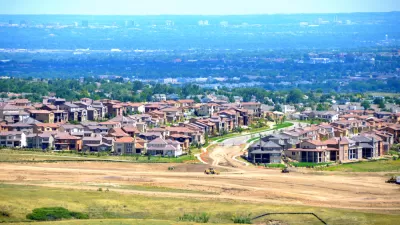The idea that half the world's population has moved to cities, with more coming soon, misses a fundamental fact about cities: many of them are actually suburbs.

An article by Courtney Humphries debunks the commonly cited statistic that half the world's population is living in cities. Karen Seto, a geographer at Yale University, is quoted directly to describe the lost nuance of that claim: "We don’t have 50 percent of the world living in cities….A lot of these people are living in towns and small centers." Or, as Humphries adds, "a far cry from Dubai."
Humphries credits the misconception to a 2007 report by the United Nations as well as the May special issue of the journal Science. An article also from May, by Randy Rieland, made a similar claim about the U.N. report in support of a different argument about the future potential of suburbs.
The problem under examination here: since the U.N. report, many people have been too quick to jump to conclusions about the definitions of "urban" and "city," when in fact many countries define those terms differently and in every country they mean more than one type of place. Humphries follows through to the consequences of the misconception:
Swapping one term for another seems like a harmless convenience. But it directs the attention on urbanization toward big cities — which are iconic and visible places — and away from less exciting areas, such as vast tracts of houses on the fringe of cities, or smaller but increasingly people-packed townships.
Not only does a too-narrow definition erase the many worthy people and causes that live and work in suburbs and small towns, a too-narrow definition also erases the negative externalities of suburban development patterns. Humphries describes that latter consequence as "[missing] the realities of where we live and how our sprawling ways are changing the world."
FULL STORY: Cities Are Not as Big a Deal as You Think

Maui's Vacation Rental Debate Turns Ugly
Verbal attacks, misinformation campaigns and fistfights plague a high-stakes debate to convert thousands of vacation rentals into long-term housing.

Planetizen Federal Action Tracker
A weekly monitor of how Trump’s orders and actions are impacting planners and planning in America.

In Urban Planning, AI Prompting Could be the New Design Thinking
Creativity has long been key to great urban design. What if we see AI as our new creative partner?

King County Supportive Housing Program Offers Hope for Unhoused Residents
The county is taking a ‘Housing First’ approach that prioritizes getting people into housing, then offering wraparound supportive services.

Researchers Use AI to Get Clearer Picture of US Housing
Analysts are using artificial intelligence to supercharge their research by allowing them to comb through data faster. Though these AI tools can be error prone, they save time and housing researchers are optimistic about the future.

Making Shared Micromobility More Inclusive
Cities and shared mobility system operators can do more to include people with disabilities in planning and operations, per a new report.
Urban Design for Planners 1: Software Tools
This six-course series explores essential urban design concepts using open source software and equips planners with the tools they need to participate fully in the urban design process.
Planning for Universal Design
Learn the tools for implementing Universal Design in planning regulations.
planning NEXT
Appalachian Highlands Housing Partners
Mpact (founded as Rail~Volution)
City of Camden Redevelopment Agency
City of Astoria
City of Portland
City of Laramie





























